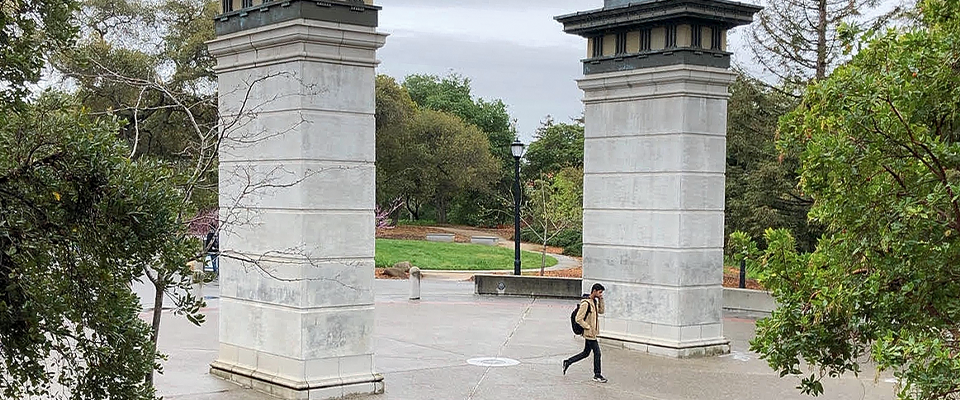The latest news from our quarterly columnist
Two Berkeley Sophomores Take on the Fight Against Misinformation
According to a 2018 Pew Research analysis, two-thirds of political links shared on Twitter are actually written by bots. But in 2017, two UC Berkeley sophomores, Ash Bhat and Rohan Phadte, launched a counterattack: NewsBot, an app that identifies the political bias of a news story. Next came Botcheck.me, a browser extension that uses artificial intelligence to unmask bots posing as real people. In its first year, Botcheck.me flagged nearly 1 million Twitter accounts as probable bots, and its associated website shows what those bot networks are tweeting about in real time. Duly impressed, the Democratic National Committee commissioned them to write a report on the spread of disinformation on social media.
The pair also developed an app called Presidential Actions, which they created less than 24 hours after Donald Trump threatened to yank funding from Cal in the wake of disturbances on campus surrounding a planned appearance by Breitbart writer Milo Yiannopoulos.
“We were, like, ‘WTF?’ First, people come and destroy our school, and now the president of the United States is going to pull funding?” says Ash. So they built an app that scrapes the White House website and sends out push notifications every time he makes a proclamation.

Emboldened by their success, they decided to do what other tech innovators before them had done: drop out of college and form their own company, RoBhat Labs.
RoBhat Labs’ first product was SurfSafe, a free browser extension that judges the likelihood that an article is trustworthy, determines if an image was pirated from another site, and flags visuals that have been photoshopped.
Ash and Rohan go back to their childhoods in San Jose. Each was the science hotshot at their respective elementary school—Ash as a coder, Rohan as a roboticist—and they kept hearing about this amazing science wiz at the other school. They finally met in middle school and have been friends ever since.
When they arrived at Cal, they moved into a house on Fulton Street that they still share—and now also serves as headquarters of RoBhat Labs.

Recently, they unveiled their biggest project to date: a mobile browser named Command. What sets it apart is what it doesn’t do: It doesn’t have ads, and it doesn’t share your data with anyone. In fact, it doesn’t even store your data. But you’ll have to pay for it.
“If you aren’t paying for the product, you are the product,” Ash explains. “We want to work for the user, not the advertisers. We set the price at $4.99 because it’s enough to support our work but still affordable enough for anyone who wants it.”
Footnote: Though they have left Cal, Cal hasn’t left them. RoBhat Labs is now a case study in a course at the Haas Business School, taught by former NBC Bay Area anchor Diane Dwyer.
Charles Shere, Real-Life Renaissance Man
One day 50 years ago, I was watching KQED, the PBS station in San Francisco, when I was struck by a rich baritone announcing the next program.
I immediately called a friend of mine at the station and asked, “Who is that announcer?”
“He’s a lot more than just an announcer,” she said. “His name is Charles Shere, and he’s a true Renaissance man. He’s a composer, music critic, teacher, and a carpenter, among other things. I hope you get a chance to meet him some day.”
I finally did, 15 years later, when I joined the Oakland Tribune, where Charles was the music critic. He was everything my friend said: music director at KPFA; producer at KQED; professor of music history and composition at Mills; author of numerous books, including Why I Read Stein and How I Saw Duchamp; and recipient of two fellowships from the National Endowment for the Arts—one as an art critic and the other as an opera composer.

Shere was also one of the founders of Chez Panisse. He and his wife, Lindsey Remolif Shere ’57, the restaurant’s original pastry chef, still own a piece of the place.
“We lived at one end of the 1900 block of Francisco Street between Grove and Milvia, and Alice [Waters (’67)] was living with David Goines at the other end,” he says. “We’d troop to their house and have crepes that Alice made, then back to our house for dessert that Lindsey made.”
He wrote for the Tribune from 1972 until his retirement in 1988, after which he and Lindsey moved to Healdsburg in Sonoma County. Naturally, Charles built the house they are living in. “I used some power tools, but as little as possible.” Nowadays, he spends his time rereading his favorites: Ovid, Horace, and Epicurus, writing his memoirs—he’s already published two volumes and is finishing the third, with the final volume still to come—and battling what he calls “an indolent case” of prostate cancer.
Charles was born in Berkeley in 1935 but grew up in Sebastopol, where he and his family lived for ten years in ten different houses. “That’s the way it was in those days: Depression and war and all that.”
He received his B.A. summa cum laude from Cal in 1961, but it took him nine years to get it.
“I started out at a religious college in Los Angeles called Chapman, then Santa Rosa Junior College, then San FranciscoState, and finally Cal. Suddenly, I was in a situation where people trusted me to do my own reading and my own thinking.

“I was an English major because I love music. I wanted to write music, but I didn’t want to make a living in music because the work might compromise my music—the work being teaching music history. It didn’t work out that way, and I ended up teaching music history at Mills.”
His many compositions include operas such as The Bride Stripped Bare by Her Bachelors, Even (after the objet d’art byMarcel Duchamp), and “Composition as Explanation,” a setting of a Gertrude Stein lecture for solo piano and speaking voice, which was premiered at the Osaka Music Festival.
“It’s the only piece of mine that I’ve never heard because no recording was made,” he says. “Any memory of the event was eclipsed by the events of that day—November 22, 1963.”
Looking back, he says one of his happiest times was when he was writing for the Tribune. “It shows you what the paper was willing to print in those days—longish articles about things I liked writing about. It was amazing, and, of course, I was complaining about how restrictive it was compared to the good old days.”
On Dec. 15, Charles Shere passed away. In a letter to friends, his wife of nearly 64 years, Lindsey Shere, wrote, “I treasure those years and feel privileged and so lucky to have been able to share them with such an extraordinary man.”
The Story Behind the Northside Gate
Oct. 16 marked the 30th anniversary of the dedication of the Class of 1954 Gate at the campus entrance where Hearst meets Euclid, but there was no public celebration due to the coronavirus pandemic.
The story of the gate begins with Chancellor Ira Michael Heyman, who wanted to create 100 new endowed chairs on his watch. He asked every class observing its 35th anniversary to fund one of those chairs.
The ’54s were perfectly willing, and they endowed a chair to reward excellence in undergraduate teaching. But they also wanted to do something else: create a permanent architectural monument, a gate on the Northside to complement Sather Gate on Southside.

Easier said than done. It would require a whopping quarter of a million dollars, no small sum in those days. So the class formed a committee chaired by Bill Morrish, Midge Oliver Zischke, and Don Denton, collectively known as The Troika, to raise the money.
Cal architecture alums were invited to submit proposals, and 113 entries were accepted. The winner was a design featuring 12 metal standards resembling flagpoles, but the committee members wanted a gate that looked like a gate. The winning architecture firm got to keep the prize money, but the actual job was given to the second-place finisher, resulting in the twin pillars we see today.
The ground-breaking was held at the class’s 35th reunion on Nov. 17, 1989. All three members of The Troika were decked out in blue blazers and gold hardhats and armed with ceremonial picks and shovels.

Three honorary members of the class were there, too: Garff Wilson ’31, the man who wrote the Andy Smith eulogy that is read aloud the night before each Big Game; restaurateur Larry Blake, whose rathskeller was home away from home for decades of Cal students; and Agnes Robb ’18, Robert Gordon Sproul’s secretary for almost 50 years, who donated $10,000 to underwrite a book to serve as a historical record for the campus archives.
But Chancellor Heyman wasn’t there. “He’d much rather be here than where he is,” Vice Chancellor Mac Laetsch told the crowd. “He’s meeting with the regents.”
One year later, the gate was ready for its dedication. As a final touch, Lesley Walsh and Jack Ken designed a stainless-steel time capsule filled with Cal memorabilia from the ’50s to be set in the pavement between the towers.
At the dedication, Walsh noted that, “In St Paul’s Cathedral in London is a simple tablet of its great builder, Christopher Wren, that says ‘If you seek his memorial, look about you.’ Well, this isn’t St Paul’s, but it will do very nicely for the class of 1954.”
Reach Martin Snapp at catman442@comcast.net.





















